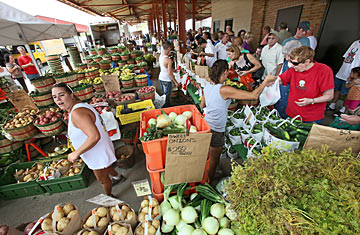
The West Allis Farmers Market in West Allis, Wisconsin, draws a bushel of customers, not to mention an ample supply of produce.
Could the trouble with money be that it's...too fast? Sure, you may think, it leaves your pocket too fast. But Woody Tasch, a longtime investment professional and founder of the Slow Money Alliance, is talking not about anyone's spending habits but money as a system: as money increasingly functions as electronic blips shuttling from screen to screen in speculative transfers, it becomes divorced from its effects in the real world and less reflective of actual wealth. The result, he says, has been bad for our economy, the planet and the individual investor. The antidote, according to Tasch, is expressed in the subtitle of his book, Inquiries Into the Nature of Slow Money: Investing as if Farms, Food, and Fertility Matter.
The Slow Money Alliance, set up as a nonprofit, brings the tenets of the Slow Food movement (buying local) to finance — exploring investment vehicles that re-circulate within the local economy, minimize environmental impact, stress diversity over monoculture, and earn decent returns. Tasch wants to give investors a stake in "restorative economy," building the food and ecological infrastructure on a community to community basis.
"The Slow Food movement has helped raise consciousness about where food comes from, down to the farmer," says Tasch. "We're doing the same thing with money — where does it come from, and, when you spend or invest, where does it go?" In Tasch's vision that covers everything from seed companies to farms to markets and restaurants.
Tasch has devoted much of his career to merging asset management and philanthropy. Most recently, for 10 years up to 2008 he was Chairman of Investors' Circle, a network of venture capitalists, angel investors, and foundations that uses private money to promote the shift to a sustainable economy. Here, Tasch incubated the ideas (and ideals) that became Slow Money.
This week, in Santa Fe, marks the official launch of this tortoise-beats-the-hare economic model. While Slow Money Institutes—forums for building regional stakeholder networks — have taken place in Grafton, Vt, Point Reyes, Calif., Bellingham, Wash., and Madison, Wis., this gathering brought together 300-plus participants representing at least four countries drawn from investment, philanthropic, academic and entrepreneurial circles.
The individual businesses he's zeroing in on may be small, but Tasch is thinking big: "We're setting out to build an organization of one million Americans to invest in food systems around the U.S." He envisions "catalyzing investments of $25 million a year or more as a first step." Though he is only now starting to raise money, Tasch says the response to his model has been "extremely heartening."
Slow Money differs from traditional socially responsible investing in that the partnerships are deeper, as the Alliance works to build not just a firm's profitability but also supportive structures. For example, rather than just lending money for, say, a farmer's barn, they would look at the farmer's other infrastructure needs, such as storage, retail outlets, transport to markets, etc. Also, inherent to the model is the notion that part of the "return" is the social and environmental benefit a company represents.
So what about the "slow" part? For the investor looking to realize returns, will you ever get there? Yes, says Mark A. Finser, Founder/General Partner of TBL Capital in Sausalito, CA. As a "snapshot of a short period of time" the conventional investment model may look good, but "I fundamentally believe that in the long run there will be better returns" with Slow Money type investments, he says. This is particularly true, he adds, when "we look at investing as an extension of our lives and values." He notes that RSF Social Finance, which invests in enterprises committed to improving society and the environment and where he served as President and CEO and is now Chairman of the Board, realized a steady 3%-4% average over 25 years and has continued to grow despite the current downturn.
The Slow Money investment model — with its local, hands-on orientation — gives business owners the means to stay true to their mission during critical growth periods, says Tom Stearns, President of High Mowing Organic Seeds, an organic seed company in Wolcott, Vermont, who participated in Vermont's Slow Money Institute in November, 2008. Traditionally, when a company takes investment money, that means setting itself up to sell, he says. "How else do investors make money? But if you're mission- or place-based, that's the first thing to go out the window," he says. "I think a new generation of investors also doesn't want that to happen. They're thinking, 'Hey, I don't want to invest in you if you're going to sell to Coca Cola in three years.'"
